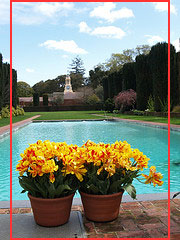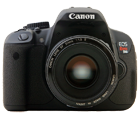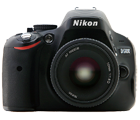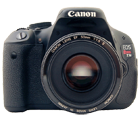The Canon 350D vs the Olympus E330
In this head-to-head, I'll compare the Canon 350D vs the Olympus E330.
This analysis should help you out if you've been comparing these two cameras and can't decide which one to get.
We'll take a look at some of the similar features, then talk about the real differences between the Canon 350D vs the Olympus E330.
You may discover a surprising difference that you weren't aware of that will help make up your mind.
Feature Comparison
Let's begin this analysis of the Canon 350D vs the Olympus E330 with a basic feature comparison.
| Canon EOS 350D | Olympus E330 | |
| Megapixels | 8.0 | 7.5 |
| ISO Range | 100-1600 | 100-1600 |
| Autofocus | 7-area | 3-area |
| Max Shutter | 1/4000 | 1/4000 |
| Crop Factor | 1.6 | 2.0 |
| Continuous Shots | 2.8fps | 3fps |
| LCD Size | 1.8 inches | 2.5 inches |
| Memory Card | Compact Flash | Compact Flash, xD |
| Special Features | Low ISO noise | Live preview, Cleaning sensor |
Canon Advantages
Standard Print Size Images

A key difference between these two cameras has to do with the images they produce.
The Canon 350D takes photos with the same dimensions as a 4x6 print (also called a 3:2 aspect ratio).
When you print your 350D photos at 4x6, virtually no cropping of the image will occur.
The aspect ratio of E330 images is 4:3, which means that every 4x6 print that you make of these photos will be cropped in some way.
The photo to the right shows you how much of an E330 photo will get cropped: anything outside the red box won't be included in the printed image.
Lens Compatibility
The same issue that affects the sensor size on the Olympus E330 also has an impact on lenses.
For their digital SLR cameras, Olympus adopted a new system called four thirds (hence the 4:3 aspect ratio of the sensor).
Four thirds cameras are most compatible with four thirds lenses, which means that old Olympus lenses won't work very well with this camera.
You can buy an adaptor so that you can attach old lenses to the E-330, but autofocus won't work and you are limited to certain camera settings. Read the full Olympus compatibility chart to find out more.
With the Canon 350D, you can use any one of the over 50 lenses Canon produces, even if you have an old Canon lens for a film SLR.
Ease of Use
The Canon Rebel XT is designed with the amateur photographer in mind.
It is pretty easy to find all of the most common camera settings, and not a lot of effort to adjust any of the custom settings.
The Olympus E330 has so many menus and settings that it can be intimidating to the beginner.
The User Manual is an absolute necessity for the E330, while you can probably get away without it using the 350D.
Olympus Advantages
Large Live View Flip-out LCD
The LCD is the star of the Olympus E330.
First, it measures 2.5" compared to the Canon's 1.8" - this makes viewing images significantly easier.
Second, it flips out from the camera body, allowing you to take photos from high and low angles.
Third (I saved the best for last), it is the only LCD on a digital SLR that provides a live preview of the image you are about to take.
On the 350D you can use the LCD to review photos and change menus, but not to compose images.
Self-Cleaning Sensor
Dust is a real problem in digital SLR cameras, because you can remove the lenses.
Once you remove the lens you are exposing the sensor to dust, and once dust gets on the sensor, it shows up as spots in every photo you take.
If you get dust on the Canon 350D sensor, you can try to clean it yourself (a delicate process) or have it professionally cleaned.
The E330 has a special sensor that vibrates every time the camera turns on.
This ensures that your images are always dust-free, even if you change lenses a lot.
Four Thirds Lenses
In the section above where I was comparing the 350D vs the Olympus E330, I noted that you can't use old Olympus lenses with this camera.
If you already own Olympus lenses, this is a drawback.
If you don't, it's worth taking a closer look at the new Zuiko four thirds lenses.
The four thirds system is designed to maximize the image quality produced by digital SLR cameras.
These special lenses works in conjunction with the sensor to create images with extreme clarity and impact.
The four thirds lenses are also lighter than other standard lenses made by Canon and Nikon. This doesn't matter too much for this comparison since the E330 camera body weighs more than the 350D.
Summary
This concludes our comparison of the Canon 350D vs the Olympus E330.
We covered a lot of information, so here's the quick summary.
- The Canon 350D is a better bet if you don't want your 4x6 prints cropped
- The 350D is compatible with old Canon lenses, while the Olympus only works with new four thirds lenses
- The LCD on the E330 has a live preview mode and it flips out from the camera body for high and low-angle photography
- The LCD on the E330 is significantly larger, making it easier to see
- The Olympus has a self-cleaning sensor, so you don't have to worry about dust
- There is a steep learning curve associated with the E330, while the 350D is more intuitive
- The Olympus is about $250 more than the Canon (see below)
Price Comparison
| MAKER | CAMERA | PRICE |
| Canon | EOS 350D with 18-55mm lens | $ 750.00 |
| Olympus | E330 with 14-45mm lens | $ 1,000.00 |
| Digital SLR Home | Olympus E-330 Guide |





